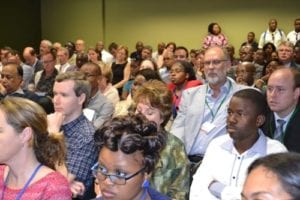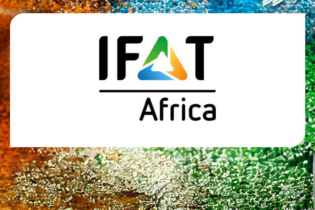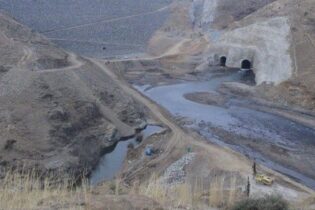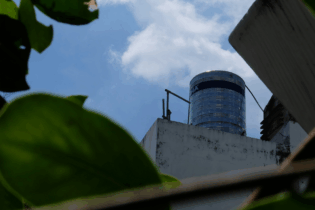The Water Research Commission (WRC), in partnership with the departments of Water Affairs (DWA) and Science and Technology (DST), has hosted the Water Research and Development Symposium at the CSIR International Convention Centre. The symposium, which was held under the theme ‘Local Water Solutions for Global Impact’, took place from 25 to 27 September 2013.
The aim of the symposium was to showcase and celebrate excellence in the South African water research and development domain and to link various institutions operating at different stages of the water innovation value chain. As part of the United Nations International Year of Water Cooperation, the symposium sought to further the scientific dialogue on what the development imperatives were for South Africa from a water perspective and the innovations that address this agenda. For the first time, the public also had a chance to engage directly in a dialogue format with the members of the Parliamentary Portfolio Committees and the scientific community outside the confines of parliament. The theme for the pre-symposium parliament session was ‘The future of water in South Africa and the role of the scientific community of practice: a public engagement session with parliamentarians’. While commenting on the symposium, the minister of Water and Environmental Affairs, Edna Molewa, explained: “We cannot progress as a country unless and until our technological advances are used for the good of all humanity. We are a water-scarce country, therefore our scientific water-related innovations and developments, including some embedded within indigenous knowledge, must and will assist us to make the necessary advances towards the attainment of our major goal: that of universal access to water services, as set out in the Millennium Development Goals.” According to the chairperson of the Parliamentary Portfolio Committee, Advocate Johnny de Lange, South Africa needs to use these technological interventions since water intensive development challenges are compounded by increased pollution loads entering river systems and aquifers that supply water for domestic users all the way to large industrial users like mines, large agriculture and major production plants. This is also occurring at a time when the country needs to make more water and sanitation services available to the unserved population, which includes making water available for new small-scale economic activities. “The final layer of complexity is to meet all these needs while ensuring the integrity of the environment. This is the South African water challenge today.” The minister of DST, Derek Hanekom, said: “The DST recognises that the water sector provides opportunities for job creation and economic development. It also sees appropriate water management and related technological innovation as key components of the transition to a green economy in South Africa, given the cross-cutting role that water plays in all sectors.” Hanekom added: “Water is core to achieving the DST’s Global Change Grand Challenge, as well as broader national targets around the green economy. It has therefore become clear that there is a need for a national water research, development and innovation roadmap, which will clarify the role that water plays in the green economy and what kind of investment the sector needs to function optimally. The DST is partnering with the WRC in this regard to develop the roadmap, which aims to provide a 10-year platform for research, development and innovation in the water and wastewater sectors of South Africa and, among other things, to provide a platform for the country to compete with leading countries in water technology, increase the numbers of technology-based small- and medium-sized enterprises operating in the water sector, and increase access to water and sanitation in rural communities.” Various WRC-funded research projects were showcased in the ‘Market Place’ by various project teams involved, among them: 1) Fog water harvesting for SA conditions While South Africa is facing a major water crisis, the impact of water shortages is felt most acutely in rural areas where there are no major surface- or groundwater resources and where it is not economically viable to install a water reticulation network. It is imperative that such communities be supplied with water. One of the more unconventional sources of water is fog. During the Water Research and Development Technology Symposium, researchers from the University of Pretoria showcased two of WRC-funded innovations on fog harvesting. A scale model ofthe whirly and a fully functional low flowmeter were exhibited. The first innovation is a measuring instrument for low and intermittent water flow. The volume of fog varies considerably from hundreds of litres per day to less than one. Water collection is also intermittent, with a lot of water collected during wet conditions to none during sunny periods. Conventional water flowmeters invariably fail during these conditions. Prof Johan van Heerden, a leading researcher based at the University of Pretoria, has built a low flowmeter (LFM) that can measure such flows. It is based on a tipping bucket principle but can measure 1 to 1.5 litres per tip. The LFMis made from perspex to enable easy identification of blockages. The system has been tested for the past two years – under field conditions – and is robust and accurate. The second innovation is an apparatus that can be used to harvest fog water during near-windless conditions (the Whirly). The previous systems – and those used world-wide – are static nets that rely on fog-bearing winds to blowthrough the system, depositing tiny fog droplets of water on the screen.These droplets then coalesce, become heavier and trickle downwards. They drip into agutter attached to thebottom of the screen.From there the fog is channelled to storage tanks. The new ‘invention’ consists of avertical shaft with three nets attached. An electronic system has been attached that causes a rotor to turn – thereby rotating thenetswhen the relative humidity reaches 98% (as it does during foggy conditions). The system switches off when the fog ceases. The batteries that drive the system are charged by means of solar power. How does fog water harvesting work? Fog occurs frequently along the West Coast of South Africa as well as in the mountains forming the southern and eastern escarpment. The WRC has funded research projects to determine the feasibility of fog water harvesting and to optimise the structure and design of fog water harvesting systems.Each system comprises of a water collection screen and one or more storage tanks. The screen consists of three 6-m wooden poles mounted 9 m apart. Steel cables stretch horizontally between the poles and anchor the structure. Two sections of 9 x 4 m shade cloth netting (40%) are draped over the top cable and secured to the middle and lower cables and to the poles on either side. This forms a fog collection screen of around 70 m2. A gutter is attached to the lower ends of the screen. During foggy and wet conditions, droplets are blown against the screen and deposited on it. As the drops become larger, they trickle downwards and drip into the gutter. From there the water is channelled through a sand filter to a pipe that leads to10 000 ℓ tanks located down slope. When the top tank is full, the overflow is channelled to the next tank further down the hill, and so on. These fog harvesting technologies have been piloted in the West Coast at a small mission station called Lepelfontein in the Northern Cape, and the other at the Tshanowa Primary School in the Soutpansberg in Limpopo. There are no naturally occurring water sources at Lepelfontein or at Tshanowa. Water was previously trucked to Lepelfontein from the nearest town, located about 70 km away, while at Tshanowa. Women and children had to collect water on a daily basis from a dam located 5 km from the school. The terrain is exceptionally steep and rugged in this area. The amount of water available to each family was thus limited to the amount of water that could be carried per trip. The design of the collector was based on that used in Chile, with significant modifications being made for South African conditions. The structures were specifically designed to be used in rural areas, to be as cost effective as possible, to use material that is readily available in the area, and to be suitable for use in areas without electricity.“The systems at Lepelfontein and Tshanowa were our first designs that were based on the Chile model. We have further developed new modifications and innovations. One modification is that instead of having one flat vertical panel, we now put three panels (30 m2 each) in the form of a triangle. This provides stability to the system during storms. The other new innovations are the Whirly and the low flowmeter,” explains Prof Jana Olivier, WRC project leader from the University of Pretoria.
Approximately the same results were obtained for both sites. The mean daily water yields were approximately 4ℓ/m2/d, with maximum yields exceeding 3 800 ℓ/d. Although these yields are not very high, they provide clean water to people who previously did not have easy access to any water. Unfortunately, a number of problems were experienced as a result of severe storms and lack of maintenance and vandalism. This necessitated modifications to the design so as to optimise water harvesting. 2) Providing real-time data to aquatic scientists Aquatic scientists will now rely on the newly developed local biotelemetry system to understand animal behaviour in water. For the past four years the WRC has been funding a series of studies, which has led to the development of a locally produced biotelemetry system to monitor the behaviour of aquatic organisms in South Africa. Biotelemetry involves the use of transmitting devices to monitor the behaviour and physiology of animals in their natural environment. This monitoring technique is proving to be increasingly useful to researchers around the world. Biotelemetry devices allow researchers to document, for long uninterrupted periods, how undisturbed organisms interact with each other and their environment in real time. Through collaborative efforts between the Water Research Group at North West University (WRG-NWU), the Centre for Aquatic Research at the University of Johannesburg, Scientific Services at South African National Parks, E Oppenheimer & Son and biotelemetry system specialist Wireless Wildlife International, the technology has now been successfully developed and tested in the field. Project leader Dr Gordon O’Brien of the WRG-NWU explains that biotelemetry methods are internationally recognised as one of the most effective ways of acquiring behavioural information of fishes and other aquatic animals over extended periods within their natural environments. “We are particularly interested in using the behaviour of these organisms to develop our understanding of their biology and ecology and then to evaluate the impact of changing environmental variables such as water quality, quantity or flows and habitat on their behaviour. This will allow us to establish management guidelines for these environmental variables, which will contribute to the conservation of species.” The biotelemetry system makes use of remote and manual tracking or monitoring systems as well as smart tags or transceivers. The latter is attached to the organism being monitored. Once tagged, the animals (in the case of the study fish and crocodiles) are released to re-establish their normal behavioural patterns. With remote and manual monitoring systems, researchers now monitor the continuous behaviour of the animal for at least a year. The remote monitoring systems include the use of ‘listening stations’ or receivers that are deployed into the study area. These record and transmit information from the tags at a 10-minute interval to an Internet-based data management system. The researchers can log onto the data management system at any time from any computer with Internet access and download real-time behavioural data from the tagged animal. In turn, manual monitoring systems involve the use of directional antennae and hand-held receivers that are used to locate and download behavioural data from any tagged animal in the field. The type of behavioural aspects of the aquatic organisms that can be monitored include the location of the animal, the movement and activity as well as some environmental variables, including the depth of the animal in the water, as well as the temperature in the water. In addition, by monitoring the location, movement and activity of the animal over extended periods of time, the team is able to evaluate the response of the animal to changing habitat variables, flows, water quality components and weather variables, such as atmospheric pressure. Tests have been conducted on yellowfish, tigerfish and one Nile crocodile. These animals were tagged and then released and monitored for eight months in the Crocodile River. Behavioural data, including home range, habitat use, daily and seasonal movement patterns, daily activity patterns, as well as the response of the animals to changing environmental variables were described and statistically analysed. The local biotelemetry system has proven itself to work well in the field. “This technology allows authorities to react more quickly, not only protecting our biodiversity but also affording a greater chance to apprehend polluters,” explains Bonani Madikizela, research manager at the WRC. This means that when the behaviour of species indicates that environmental thresholds have been reached, for example, through reduced flows or a chemical spill into a river, managers will be able to respond accordingly. “We may even be able to use fish behaviour in real time to release ecological flows at the start of migration. This will result in a better ability of decision-makers to manage and conserve our precious ecosystems,” explains O’Brien. Further developments in remote and manual biotelemetry monitoring methods and analyses techniques are continuing. It is hoped that this technology will go a long way towards the conservation of South Africa’s rich aquatic biodiversity.







